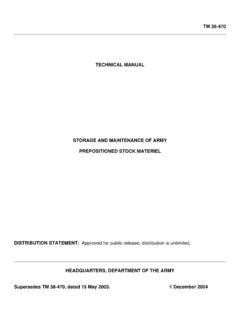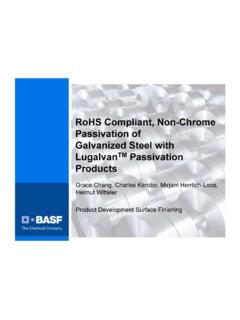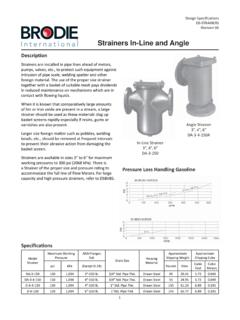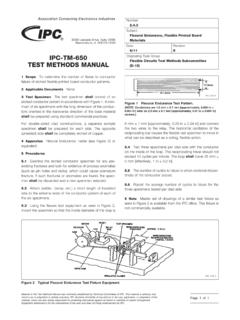Transcription of NEW MECHANICAL DISRUPTION METHOD FOR …
1 SOUTHEAST ASIAN J TROP MED PUBLIC H EALTH. NEW MECHANICAL DISRUPTION METHOD FOR EXTRACTION. OF WHOLE CELL PROTEIN FROM CANDIDA ALBICANS. SF Wong, JW Mak and PCK Pook International Medical University, Bukit Jalil, Kuala Lumpur, Malaysia Abstract. Cell DISRUPTION or lysis is a crucial step to obtain cellular components for various biological studies. We subjected different concentrations of Candida albicans to 5, 10, 15 and 20 cycles of DISRUPTION . The degree of cell lysis was observed using light microscopy and the yields obtained were measured and analysed. The optimum extraction with 1 x 1010 yeast cells/ml was achieved after 5 cycles of DISRUPTION with mm diameter glass beads at 5,000. rpm. Approximately 80% of the cells were lysed and the protein yield was 6,000 g/ml.
2 SDS- PAGE analysis revealed approximately 25 distinct protein bands with molecular weights rang- ing from 8 kDa to 220 kDa. We conclude that this MECHANICAL DISRUPTION of fungal cells is a rapid, efficient and inexpensive technique for extracting whole cell proteins from yeast cells. INTRODUCTION taining -1, 4 bonds (Chaffin et al, 1998;. Martinez et al, 1998). Cellular DISRUPTION of fungi is a crucial step Cell DISRUPTION technology can be divided in obtaining maximum amounts of soluble cel- into MECHANICAL and non- MECHANICAL meth- lular contents with maximum biological activ- ods. MECHANICAL methods include ultrasonic ity and with minimum denaturation, proteoly- DISRUPTION (sonicator), MECHANICAL agitation sis and oxidation. The fungal cell wall is ex- (homogenizer, mortar and pestle, blender) and tremely difficult to disrupt because of its com- pressurized DISRUPTION (French press).
3 The plex nature compared with mammalian cell non- MECHANICAL methods consist of chemical membrane. The cell wall of Candida albicans permeabilization (cationic/anionic detergents), is a multilayered structure located externally physical DISRUPTION (osmotic shock, pressure to the plasma membrane and while providing release, freezing and thawing) and enzymatic rigidity to the cell, acts as a permeable bar- permeabilization (lyticase, zymolyase, protein- rier, which protects the protoplast against ase K). physical and osmotic injury. The major com- ponents (80 to 90%) of the cell wall are car- To our knowledge, there is no report on bohydrates and consist of (1) mannan or poly- an efficient MECHANICAL METHOD for fungal cell mers of mannose covalently associated with wall DISRUPTION for optimum extraction of fun- proteins to form glycoproteins (mannoproteins) gal whole cell protein.
4 In this study, we report (2) -glucans, which are branched polymers a new MECHANICAL METHOD we developed to of glucose containing -1, 3 and -1, 6 link- increase the efficiency of fungal whole cell pro- ages, and (3) chitin, which is an unbranched tein extraction. homopolymer of N-acetyl-D-glucosamine con- MATERIALS AND methods . Correspondence: Wong Shew Fung, International Medical University, Bukit Jalil, 57000 Kuala Lumpur, Culturing of Candida albicans Malaysia. C. albicans was grown in YPD medium Tel: 603-86567228 ext 1003; Fax: 603-86567229 (1% yeast extract, 2% bacteriological peptone E-mail: and 2% D-glucose) at 37 C for 72 hours on a 512 Vol 38 No. 3 May 2007. EXTRACTION OF PROTEIN FROM C. ALBICANS. shaking incubator (Certomat SII and Certomat buffer (Bio-Rad) containing mM Tris-HCl H, B Braun Biotech International, GmbH, (pH ), glycerol, 1% SDS, Melsungen, Germany).
5 The yeast cells were bromophenol blue and -mercapto- harvested, washed with sterile phosphate- ethanol (Sigma-Aldrich, St Louis, MO, USA). buffered saline (PBS) three times by Samples were centrifuged at 12,000g for 5. sedimenting at 2,000 rpm for 10 minutes and minutes to prevent streaking during electro- then re-suspended in sterile PBS. The num- phoresis and kept on ice before loading into ber of yeast cells was determined with a the wells. hemocytometer and adjusted to the desired Samples were separated in (w/v). concentrations (106, 108 and 1010 yeast cells/ polyacrylamide gel using the discontinuous ml) for the cell DISRUPTION experiment. buffer system of Laemmli (1970) using TV400. Cell DISRUPTION Maxi (20 x 20 cm) vertical electrophoresis unit Polystylene sample tubes ( ml, Tomy (Scie-Plas, UK).)
6 Electrophoresis was per- Degital Biology) were used throughout the formed at room temperature at a constant experiment. Approximately to g of voltage of 120V for stacking gel and 150V for mm diameter glass beads (Tomy Degital Biol- resolving of polypeptides. Gel was stained with ogy) and 1 ml aliquot of each concentration SimplyBlue SafeStain (Invitrogen Corporation, of C. albicans was added into each tube. The California) and photographed. samples were cooled at -80 C for 60 seconds The relative molecular weights of the before being subjected to DISRUPTION with a polypeptide bands were estimated by com- Micro SmashTM beads cell disrupter/micro ho- paring their electrophoretic mobilities with mogenizing system (MS-100, Tomy Degital those of known molecular weights of pre- Biology) for 120 seconds at 5,000 rpm.
7 The stained SDS-PAGE standards (Sigma samples were then cooled at -80 C for 5 min- ColorBurst Electrophoresis Markers). The utes and the DISRUPTION cycle was repeated. standard molecular weight markers used were: Representative samples after 5, 10, 15 and violet, 220,000 Da; pink, 100,000 Da; blue, 20 DISRUPTION cycles were obtained for pro- 60,000 Da; pink, 45,000 Da; orange, 30,000. tein concentration determination, sodium Da; Blue, 20,000 Da, pink, 12,000 Da and dodecyl sulphate - polyacrylamide gel elec- blue, 8,000 Da. trophoresis (SDS-PAGE) and microscopy. The Microscopy examination tests were conducted in duplicate. Undisrupted and disrupted yeast samples Determination of protein concentration were examined under 400x magnification us- Concentrations of the lysates were de- ing a Leica DMLS compound microscope and termined using Bio-Rad Protein Assay (Bio- the degree of fungal lysis was assessed visu- Rad Laboratories, Hercules, CA) based on the ally.
8 The images were captured using a METHOD of Bradford (1976). The absorbance megapixal digital camera and documented was measured at 595 nm with a spectropho- using an image pro software. tometer (Spectro UV-Vis Auto, LaboMed, Cul- ver City, USA), and the protein concentration RESULTS. was determined from a standard curve using Determination of protein concentration bovine serum albumin as standard protein. To assess the efficiency of this METHOD SDS-PAGE of cell DISRUPTION , we subjected different con- Protein samples were denatured by boil- centrations of C. albicans to various disrup- ing at 90 C for 10 minutes in Laemmli sample tion cycles and the total protein concentra- Vol 38 No. 3 May 2007 513. SOUTHEAST ASIAN J TROP MED PUBLIC H EALTH. tions were determined (Table 1).
9 The total pro- tein concentrations obtained ranged from 13. to 37 g/ml, 100 to 188 g/ml and 6,232 to 6,413 g/ml for 1 x 106, 1 x 108 and 1 x 1010. yeast cells/ml, respectively. The total protein obtained for 1 x 106 yeast cells/ml increased slightly as the number of DISRUPTION cycles in- creased from 5 to 20 cycles. This trend was not observed for samples of 1 x 108 and 1 x 1010 yeast cells/ml. The protein yields were similar after 5, 10, 15 and 20 DISRUPTION cycles. 1 2 3 4 5 6 7 8 9 10 11 12 13. Protein banding patterns of C. albicans follow- ing DISRUPTION Fig 1 Protein bands patterns of 1 x 10 6 (lanes 2-5), 1 x 10 8 (lanes 6 - 9) and 1 x 10 10 (lanes 10- SDS-PAGE analysis of 1 x 10 6 (Fig 1, 13) C. albicans yeast cells per ml after being lanes 2-5), 1 x 108 (Fig 1, lanes 6 - 9) and 1 x subjected to 5 cycles (lanes 2, 6 and 10), 10.
10 1010 (Fig 1, lanes 10-13) C. albicans yeast cells cycles (lanes 3, 7 and 11), 15 cycles (lanes 4, per ml after 5 DISRUPTION cycles (Fig 1, lanes 8 and 12) and 20 cycles (lanes 5, 9 and 13). 2, 6 and 10), 10 cycles (Fig 1, lanes 3, 7 and of DISRUPTION . 11), 15 cycles (Fig 1, lanes 4, 8 and 12) and 20 cycles (Fig 1, lanes 5, 9 and 13) of disrup- tion showed no protein bands on the gel for 108 yeast cells/ml sample. SDS-PAGE analy- the 1 x 106 yeast cells/ml. There were only sis showed approximately 25 distinct protein two to three light bands observed for the 1 x bands with molecular weight ranging from less than 8 kDa to more than 220 kDa for samples of 1 x 1010 yeast cells/ml. Table 1. Total protein concentrations of C. albicans Microscopic analysis of fungal cell wall disrup- after MECHANICAL DISRUPTION .







